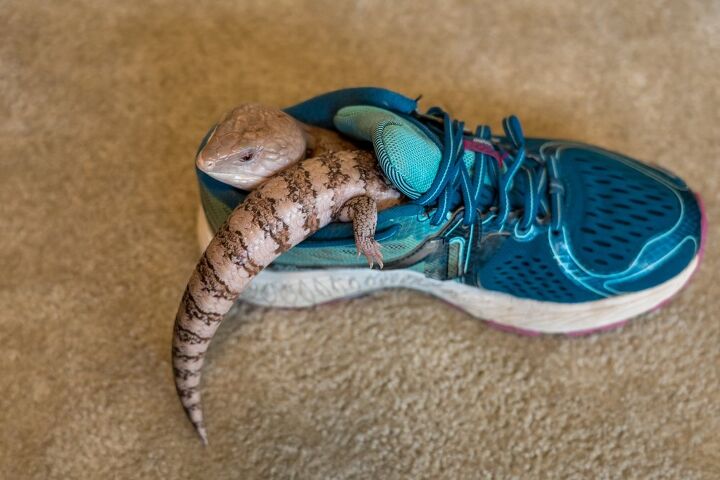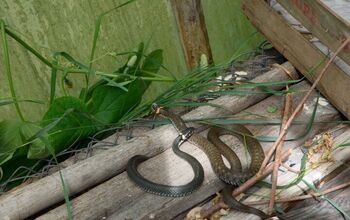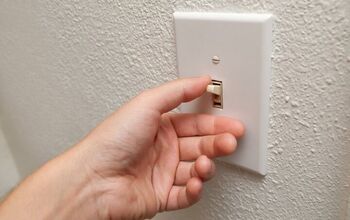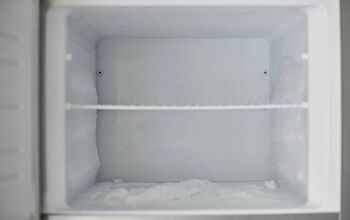How To Keep Skinks Out Of The House

Skinks may be less scary than other pests, like snakes and brown recluse spiders, but you don’t want them in your house. Your house can’t sustain skinks when they get stuck, and you’re better off deterring them from getting into your home. That said, you’re not alone if you’ve ever struggled with how to keep skinks out of the house.
You can keep skinks out of the house if you remove nearby water sources and spray the house for bugs. Removing their food source by spraying pesticides and planting natural deterrents, like marigolds, can encourage skinks to relocate. It’s also important to declutter the area around your entry doors to keep skinks away.
Weatherstripping is cheap, easy to install, and enough to seal the gaps in your doors. Sealing gaps is the easiest way to keep skinks and other lizards out of the house. Follow along as we explore how to deter skinks without harming them.
How To Keep Lizards Out Of Your House
Skinks and other lizards don’t necessarily want to get stuck in your house, but it happens. Luckily, you can reduce the risk of skinks entering your home with a few easy tips, including:
1. Install Weatherstripping
There’s no better way to keep skinks out of the house than to install weatherstripping. Weatherstripping can help fill the gaps at the bottom of your doors, which is how skinks typically get inside. It is made of several materials, such as plastic, rubber, and metal, and as its name suggests, weatherstripping comes in strips.
You can either attach these strips to your doors using nails and screws or an adhesive strip. Some people also use soft draft stoppers, which you can easily install or remove as needed. Weatherstripping can also stop air from leaving your home and keep outdoor air from coming indoors.
Naturally, this can help you save money on heating and cooling bills during summer and winter. Blocking these door gaps can also keep plenty of bugs, such as spiders, out of your house. Finally, installing weatherstripping can also help reduce noise if you live on a busy street.
2. Declutter Your Porch
If you found skinks in your home, you’ve probably also found them around your front porch throughout the spring and summer. That’s especially true if you have lots of plants, vines, fallen leaves, and other yard debris near your porch. Skinks gravitate debris because it provides shelter from predators and helps them cool off on hot days.
However, having this kind of debris near your home’s entry doors can explain why you find skinks indoors. Thoroughly declutter your porch and the area around your home’s entry doors to help keep skinks at bay. Be careful during the process, so you don’t inadvertently step on any skinks and harm them, as they often nest under debris.
Sweep up fallen leaves, prune your nearby plants, and blow debris away with a leafblower. It’s also a good idea to get rid of groundcover plants in the area, or at least cut them back. You can even relocate this debris slightly further away from your door, so the skinks still have a sanctuary.
3. Remove Nearby Water Sources
Skinks typically stay where they know they can easily survive and access food and water. That's why you may keep finding skinks in and around your house if you have a steady water source nearby. That can include water bowls for your pets, water fountains, and decorative birdbaths.
Ideally, you should move these water sources away from your home’s entry doors. In turn, the skinks may relocate further away from your home, and you won’t find them indoors. This is for their own good, as skinks often starve, get hurt, and become dehydrated when trapped indoors.
It’s also worth regrading your landscaping if water consistently pools on your lawn and in your soil beds. This can help prevent soil erosion, improve drainage, aid lawn health, and keep skinks away.
4. Deter Bugs With Plants
Skinks cannot harm humans, but they can harm bugs, and they rely on them to stay alive. The skinks you found in your house may be there because they’re simply looking for food. In some cases, they even follow bugs into your house, which means you have two problems on your hands.
You can often keep skinks out of your house if you double down on pest control and eradicate the bugs. While you can use pesticides, it’s always worth trying common bug-deterrent plants before trying chemicals. That includes mint, lavender, marigolds, basil, garlic, and chives, which you can also use in the kitchen and around the house.
These plants produce strong scents that deter bugs and make them less likely to hang around the area. Once the bugs leave, the skinks will eventually notice that their food source is gone. If that doesn’t work, you can hire a pest control service to spray your home’s perimeter for bugs, which also works.
5. Spray The Perimeter
Plants can deter bugs, which deter skinks, but repelling skinks with strong scents doesn’t stop there. For example, you can make a potent skink-deterrent spray at home with some household products. Skinks hate strong acid and spicy smells, and you can use that to your advantage.
Mix some cayenne pepper, hot sauce, and warm water in a spray bottle. Go outside and spray the area along your exterior walls and entry doors. While you’re at it, you can also spray areas with vegetation that attracts skinks, like ground cover plants.
You only need 1-2 tablespoons of cayenne pepper, especially if you’re also using some hot sauce. In that case, you should only use a few drops of potent hot sauce, and make sure to dilute it well. Otherwise, you may accidentally discolor your exterior walls and entry doors.
6. Turn Off The Lights At Night
As previously mentioned, skinks typically stay in areas where they know they can find a lot of bugs. Bugs gravitate toward bright lights at night, which you may notice while coming home from work or dinner. While it’s nice to have some outdoor lights on, it can attract bugs and skinks in equal measure.
Ideally, you should turn off the lights by your entry doors at night to keep skinks out of the house. That doesn’t mean you leave your home’s exterior looking pitch black at all times. For example, you can install motion-activated lights by your garage door and entry doors.
That way, you can easily see when you get home at night, and bugs won’t swarm the light. In that case, the lights will only briefly stay on, which shouldn’t be long enough to attract bugs. This is the safest way to keep bugs and lizards out of your house at night.
Can Skinks Hurt You?
Skinks cannot hurt you, so they won’t endanger you if they wind up in your house. However, skinks are in danger if they enter your house, as it’s not their natural habitat. They won’t find enough food and water in your house to survive, and they will immediately become uncomfortable.
While skinks aren’t dangerous, they can still bite you, and it may leave a visible mark. Don’t panic if a skink bites you, as they aren’t poisonous and don’t have large teeth. However, you shouldn’t pick skinks up by hand unless you’re a trained wildlife removal professional.
You must immediately clean your hand or wherever the skink bit you if an incident occurs. They can’t poison you, but the skink may transmit harmful bacteria through their bite. Don’t hesitate to visit a hospital or clinic if a recent skink bite has changed color and appears infected after several days. This is rare, but it’s better to be safe than sorry.
What Should You Do If You Find A Lizard In The House?
Upon finding a lizard in the house, you must stay calm and take a good look at it. Doing so can help you identify the lizard as native or invasive. For example, finding a skink at home in an area where skinks are common can tell you it’s a minor issue.
However, finding a strange, unrecognizable lizard that looks tropical may raise some red flags in the Midwest. That’s because invasive lizards sometimes hitch rides on plants, fruit, vegetables, and other goods from other states. Don’t get too close to the lizard if you suspect it’s invasive.
If it’s something simple like a skink, you can attempt to catch it with a plastic container and transport it outside. Otherwise, you can call a wildlife removal service to play it safe. Until then, it’s a good idea to isolate the lizard in one room to make the process easier.
Summing It Up
The best way to keep skinks out of the house is to put weatherstripping at the bottom of your entry doors. You can also deter skinks and other lizards if you declutter your porch and spray the area for bugs to remove their food source. Upgrade to motion-activated lights outside your home to ensure bugs and skinks don’t hang around and wander into your house.
Related Guides:

Nick Durante is a professional writer with a primary focus on home improvement. When he is not writing about home improvement or taking on projects around the house, he likes to read and create art. He is always looking towards the newest trends in home improvement.
More by Nick Durante






















![10 Most Dangerous Neighborhoods in Baltimore [Updated]](https://cdn-fastly.upgradedhome.com/media/2023/07/31/9075655/10-most-dangerous-neighborhoods-in-baltimore-updated.jpg?size=350x220)




